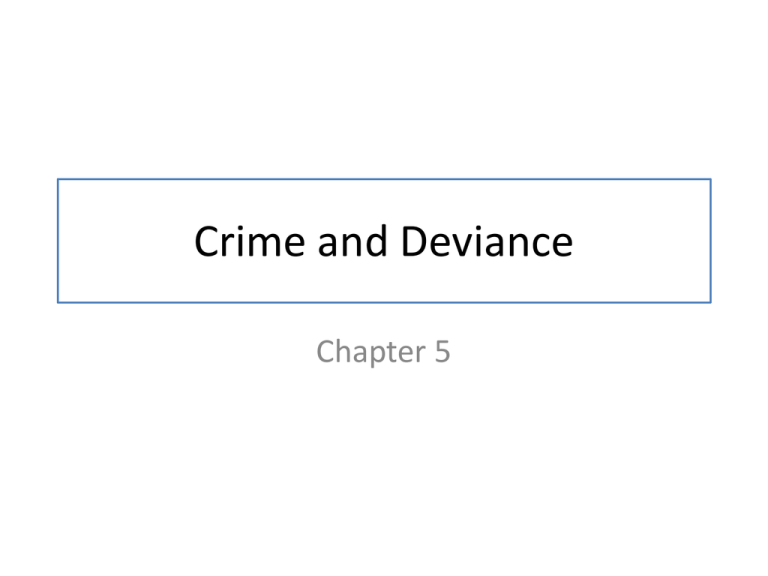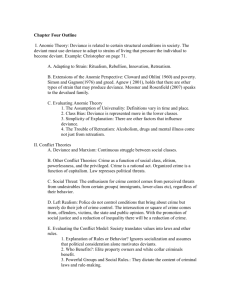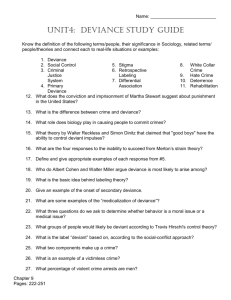Crime and Deviance
advertisement

Crime and Deviance Chapter 5 Social Control and Deviance • Social control regulates behavior within a society – Functionalists see it as indispensable – Conflict theorists see it as tool of powerful groups • Internalization of norms • Formal vs. Informal Sanctions II. Theories of Deviance • Why do people become deviant and commit crime? – Definition of theory? Theories of Deviance • Anomie Theory – Durkheim’s anomie: social condition in which people find it difficult to guide their behavior by norms that they experience as weak, unclear, or conflicting • Anomie occurs when peoples expectations about what they deserve are not met – What happens when the economy collapses? Anomie Theory • How is the American dream possibly connected to crime? • How might anomie and the American dream be connected to the formation of large gangs? Anomie Theory • Structural Strain Theory-Robert Merton – What are the acceptable means to achieving the American Dream (worldly success and material wealth)? • Securing a good education and obtaining high paying jobsMerit hard and hard work – Americans internalize goal, but may not have access to acceptable means • People adapt to inconsistency between means and goals in society. Structural limitations Strain adaptation(Crime) – Innovation » The drug dealer » The corporate executive?? • Can children and adults learn deviance? Theories of Deviance • Cultural Transmission Theory – Youths become delinquent because they associate and make friends with other delinquents • Youths learn and may be pressured into deviance – Socialization into a deviant subculture – Gang activity – Why do many argue against jail or juvenile hall for a first time drug offender or low level criminal? – Sutherland’s Theory of Differential Association • Differential association: individual’s cultural conditions help determine his/her likelihood of and attitudes towards deviance – Parole rules or a parents requests Theories of Deviance • Conflict Theory – Individuals victimized by capitalist oppression are driven by their struggle to survive to commit acts that the ruling class brands as criminal • A focus on social class and criminal activity; How does poverty contribute to crime? • How does poverty contribute to alcoholism, drug abuse, prostitution, and family violence? – The legal system reflects interests of the rich • Laws created to protect privilege and property • Differential punishment for business and street crimes • Corporate crimes cost society more$$$ – What gov’t agency keeps track of corporate crimes? – Video: Many economists proclaim that White collar crime is closely connected to the financial crisis, yet people are seldom prosecuted for it. – The FBI focuses very little attention on white collar crime Theories of deviance • To some theorists, white collar criminal activity be best be understood through rational choice theory. – People are inclined to engage in deviant behavior when it has significant rewards and limited costs – Yet conflict theorists contend that because we are not aware of the extent and costs of white collar crime, rarely do we call for measures to “get tough” on white collar crime, and when there is a call to do so, powerful industries engaged in activities will find ways to defend against new laws they see as regulations that limit their profits. • Does a student who is labeled as deviant by his teachers more likely to stop acting deviant or continue acts of deviance? Theories of Deviance • Labeling Theory – Labeling people as deviants has consequences for them • Primary Deviance: We all engage in deviant behavior; but are we caught and labeled as deviants?? • Secondary deviance: deviance individuals adopt in response to the reactions of other individuals – People labeled “deviant” typically find themselves rejected and isolated which can result in a self fulfilling prophecy Theories of Deviance – Even most deviants conform to society most of the time • Control Theory-Why don’t people deviate? – Hirschi: Elements of the Social Bond • • • • • Societal bond is crucial Attachment to others Involvement in the society’s conventional activities Commitment to other people Belief in host society’s values III. Crime and the Criminal Justice System • Crime – Examples of ridiculous crimes? • The Criminal Justice System – The land of the free? Crime and the Criminal Justice System • The Criminal Justice System – Prisons • Population steadily increasing • U.S. has highest incarceration rate in world – Why? The American Punishment Frenzy • Punitive policies • Imprisonment of non-violent offenders • 1980’s-The drug war – Mandatory minimums – Three strikes laws – Plea bargains • In 2007, the United States had the highest incarceration rate in the world • Over 7 million people in prison, jail, or under correctional supervision The American Punishment Frenzy • The Prison Industrial Complex – Correctional expansion continues not because it decreases crime and creates a safer public, but because it serves the interest of certain powerful groups that benefit from tough on crime policies and continue to push for punitive policies through lobbying political leaders and running million dollar ad campaigns • Private prison corporations • Prison guards Union • Prison labor benefits government, corporations and a variety of businesses with vested interests in correctional expansion – I.e.: Video




